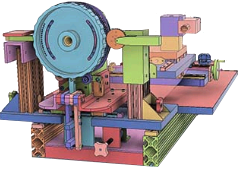
Dynamic Rosette Phasing & Lobe Multiplication
using the
Rosette Phaser / Multiplier


|
ELFOS
Dynamic Rosette Phasing & Lobe Multiplication
|

|
Calculations needed for dynamic phasing when using the Rosette Phaser / Multiplier are based on the data in the table below. Input fields on this screen are colored yellow .
Once you have entered your desired values, scroll down and click the button below, Calculate MultiSync Values
You should ensure the UCF is rotated the correct direction for the direction of the rosette's pattern rotation. When rotated correctly, there is a smooth line for the root of the helix. A light cut on the first pass can help assure proper direction of rotation.
|
|
|||||||||||||||||||||
|
or |
|
|
or |
|
|||||||||||||||||
Note, when making a left helix, the Rosette Pattern Rotation will be a negative number.
For the angle to set the universal cutting frame (UCF), imagine there is a triangle where the adjacent side is along the Z axis, and the opposite side is wrapped around the face, perpendicular to the Z axis. The image to the right shows such a triangle.
The cylinder's circumference at the Final Average Diameter is π times that. A rosette's revolution, specified in degrees (°), would of course be that portion of the cylinder's circumference. Thus, the Rosette Pattern Rotation distance is calculated as a fraction of the cylinder circumference. \begin{align*} \tag{4} Cylinder \, circumference &= \pi \cdot Final \, Average \, Diameter \\ \tag{5} Rosette \, Pattern \, Revolution \, Distance &= Cylinder \, circumference \cdot \left(\frac {Rosette \, Pattern \, Revolution\unicode{xB0}} {360\unicode{xB0}} \right) \end{align*}
For the adjacent side, we use the Z Axis Target.
The UCF Rotation Angle is then calculated using the tan-1 (arctan) calculation. \begin{align*} \tag{6} UCF \, Rotation \unicode{xB0} &= \tan^{-1} \left(\frac {Rosette \, Revolution \, Distance} {Z \, Axis \, Target} \right) \end{align*}
|
Questions or comments? Contact us at
ColvinTools@Gmail.com |
Disclaimers |